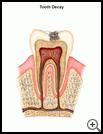
Tooth Decay Prevention
What is tooth decay?
Tooth decay is when the enamel of a tooth is destroyed. It may cause toothaches, lost teeth, malocclusion (poor bite), and costly visits to the dentist. Fortunately, modern dentistry can prevent 80% to 90% of tooth decay.
How can I help my child prevent tooth decay?
Here are some tips for raising cavity-free kids.
Fluoride
Fluoride builds strong, decay-resistant enamel and reduces cavities by 70%. Children 6 months to 16 years old need fluoride. By 16 years, the enamel formation on the 3rd molars is completed. Drinking fluoridated water (containing 0.7 to 1.2 parts fluoride per million) or taking a prescription fluoride supplement is the best protection against tooth decay.
To get enough fluoride from drinking water, a child must drink at least 1 pint of fluoridated water each day. By school age a child should drink 1 quart of fluoridated water per day. Fluoride is safe. Over half of all Americans drink fluoridated water. Fluoride has been added to water supplies for over 50 years.
If fluoride isn't added to your city's water supply or you are breast-feeding, ask your healthcare provider for a prescription for fluoride drops or tablets during your next routine visit. The dosage of fluoride is:
- 0.25 mg per day for children up to 3 years old
- 0.5 mg per day for children 3 to 6 years old
- 1.0 mg for children over age 6.
Mixing fluoride with milk reduces absorption of the fluoride to 70%. For this reason you should give fluoride to your child when he or she has an empty stomach.
Bottled water usually doesn't contain enough fluoride. Call the bottled water producer for information. If your child drinks bottled water containing 0.6 or less parts fluoride per million, ask your provider for a fluoride supplement.
One concern about fluoride is white spots or mottling on the teeth (called fluorosis). This can occur when a child has 2 mg or more fluoride per day. Children may get too much fluoride if they receive fluoride supplements when fluoride is already present in the city water supply. Occasionally they can get extra fluoride by eating their toothpaste. A ribbon of toothpaste contains about 1 mg of fluoride. Therefore, people of all ages should use only a drop of toothpaste the size of a pea. This precaution, and encouraging your child not to swallow most of the toothpaste, will prevent fluorosis.
Toothbrushing and flossing
The purpose of toothbrushing is to remove plaque from the teeth. Plaque is the invisible scum that forms on the surface of teeth. Within this plaque, mouth bacteria change sugars to acids, which in turn etches the tooth enamel.
Toothbrushing should begin before a child is 1 year old. Help your child brush at least until after the age of 6 years. Most children don't have the coordination or strength to brush their own teeth adequately before then. If your child is negative about tooth-brushing, have him brush your teeth first before you brush his.
Try to brush after each meal, but especially after the last meal or snack of the day. To prevent mouth bacteria from changing food caught in the teeth into acid, brush the teeth within the first 5 to 10 minutes after meals. If your child is in a setting where he can't brush his teeth, teach him to rinse his mouth with water after meals instead.
Brush the molars (back teeth) carefully. Decay usually first starts in the pits and crevices in these teeth.
Dental flossing is very useful for cleaning between the teeth where a brush can't reach. Flossing should begin when your child's molars start to touch. In the early years, most of the teeth have spaces between them.
A fluoride toothpaste is beneficial at all ages starting at 1 year. Adults and children tend to use too much toothpaste. An amount the size of a small pea is all that you need.
Diet
A healthy diet from a dental standpoint is one that keeps the sugar concentration in the mouth at a low level. The worst foods for your teeth contain sugar and also stick to the teeth.
If your child is a baby, prevent baby-bottle tooth decay by not letting your infant sleep with a bottle of milk or juice. After the first teeth appear give your baby a bottle of water if your child must have a bottle at night. It is better to put your child to bed after he or she is finished with the bottle.
Avoid letting your child carry around a bottle or sippy-cups during waking hours. Young children who use milk, juice or other sweetened liquid for comforting, are prone to severe dental decay.
Discourage your child from eating foods such as hard candy or sticky sweets (for example, caramels or raisins). Other high risk foods are fruit rolls, all dried fruit and gummy bears. When a child eats these foods his or her teeth are in contact with sugar for a long time. Since no one can keep children away from candy completely, try to teach your child to brush after eating it. Avoid frequent snacks and offer foods that contain sugar with meals only.
Dental sealants
The latest breakthrough in dental research is dental sealing of the pits and fissures of the biting surfaces of the molars. Fluoride does little to prevent decay on these surfaces. A special plastic seal can be applied to the top surfaces of the permanent molars at about age 6. The seal may protect against decay for 10 to 20 years without needing replacement. Ask your child's dentist about the latest recommendations.
Dentist visits
The American Dental Association recommends that dental checkups begin at the age of 1 year (sooner for dental symptoms or teeth that look abnormal). Dentists can apply fluoride varnish to new teeth at the 1 year visit.
Last modified: 2014-06-10
Last reviewed: 2016-06-01

